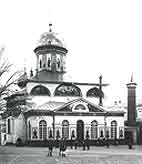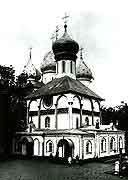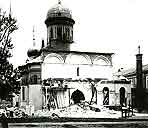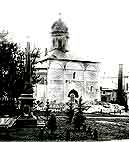G.A. MÀKÀRÎVSÊÀYA
“On the Problem of Restoration of the Architectural Ensemble
of the Trinity-St. Sergius Lavra between the 1920s and1990s
(page 2)
 The necessity of restoration was urgent because of the essential changes in the ensemble that appeared as the result of "renovations" and reconstructions of the 19th – early 20th centuries. Thus, The Trinity Cathedral became completely unrecognizable by the beginning of the 20th century. It was surrounded by porches and parvises, the gables were covered with a hip roof, the ancient windows were enlarged, the white-stone walls were covered with canvas and marble painted.
The necessity of restoration was urgent because of the essential changes in the ensemble that appeared as the result of "renovations" and reconstructions of the 19th – early 20th centuries. Thus, The Trinity Cathedral became completely unrecognizable by the beginning of the 20th century. It was surrounded by porches and parvises, the gables were covered with a hip roof, the ancient windows were enlarged, the white-stone walls were covered with canvas and marble painted.
 The Church of the Holy Ghost was in an emergency condition. Its proportions were absolutely deformed by annexes: Filaret Chapel, western parvis and tent over the tomb of Maxim the Greek, a philosopher and publicist of the 16th century. The hip roof blocked the belfry. The walls of Church became blue, and the relief decorative details were painted in dark blue oil. The Infirmary Chambers were badly deformed in the 18th century when the western line of the cells was reorganized according to the decree of Empress Elizaveta Petrovna. In the middle of the 19th century the construction of the third floor almost covered the Church of SS Zosima and Savvaty Solovetsky, the original forms of the monument were completely hidden and the walls were overloaded. And in 1915, the protest of the Moscow Archeological Society prevented the construction of the fourth floor over the Infirmary Chambers. The Crypt was arranged under the Assumption Cathedral.
The Church of the Holy Ghost was in an emergency condition. Its proportions were absolutely deformed by annexes: Filaret Chapel, western parvis and tent over the tomb of Maxim the Greek, a philosopher and publicist of the 16th century. The hip roof blocked the belfry. The walls of Church became blue, and the relief decorative details were painted in dark blue oil. The Infirmary Chambers were badly deformed in the 18th century when the western line of the cells was reorganized according to the decree of Empress Elizaveta Petrovna. In the middle of the 19th century the construction of the third floor almost covered the Church of SS Zosima and Savvaty Solovetsky, the original forms of the monument were completely hidden and the walls were overloaded. And in 1915, the protest of the Moscow Archeological Society prevented the construction of the fourth floor over the Infirmary Chambers. The Crypt was arranged under the Assumption Cathedral.
 As the result there appeared cracks on the walls and vaults. The white-stone porches and bright colors of the Tsar Palace disappeared. The gallery of the Refectory needed reinforcement. The Museum task was to save the monuments, but its means were obviously insufficient. So, in 1920, architects I.I. Ivanov and A.A. Kesler undertook the most urgent engineer and restoration works and measurements of the monuments.
As the result there appeared cracks on the walls and vaults. The white-stone porches and bright colors of the Tsar Palace disappeared. The gallery of the Refectory needed reinforcement. The Museum task was to save the monuments, but its means were obviously insufficient. So, in 1920, architects I.I. Ivanov and A.A. Kesler undertook the most urgent engineer and restoration works and measurements of the monuments.
 In 1925 -1926 Architect D.P. Sukhov dismantled the northern parvis of the Trinity Cathedral. In 1927, three windows of the altar apses were restored, and in 1928, the white-stone stairs of the northern porch of the Trinity Cathedral were dug out. Those works created more favorable conditions for preservation of the ancient icons and frescos. The Pyatnitskaya Tower, damaged by the fire in 1920, was covered with a low wooden tent-type roof of shingle. D.P. Sukhov recalled, that he could not get wood of the right size for the tent of the appropriate height at that hard time. Though the restoration works of the 1920s were carried out by separate architects at different time and without a single plan, they contributed to the investigation and salvation of the ancient monuments of the Lavra ensemble. The works were stopped in 1923, when the original establishment was reorganized into a local history and anti-religious museum.
In 1925 -1926 Architect D.P. Sukhov dismantled the northern parvis of the Trinity Cathedral. In 1927, three windows of the altar apses were restored, and in 1928, the white-stone stairs of the northern porch of the Trinity Cathedral were dug out. Those works created more favorable conditions for preservation of the ancient icons and frescos. The Pyatnitskaya Tower, damaged by the fire in 1920, was covered with a low wooden tent-type roof of shingle. D.P. Sukhov recalled, that he could not get wood of the right size for the tent of the appropriate height at that hard time. Though the restoration works of the 1920s were carried out by separate architects at different time and without a single plan, they contributed to the investigation and salvation of the ancient monuments of the Lavra ensemble. The works were stopped in 1923, when the original establishment was reorganized into a local history and anti-religious museum.
|


